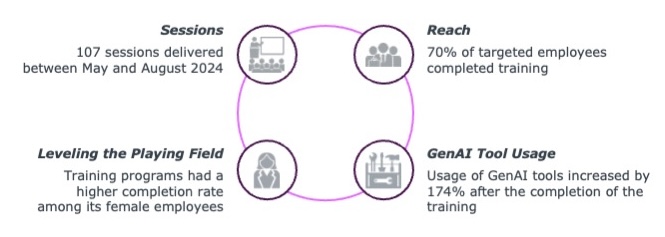GenAI tools like ChatGPT were poised to revolutionize business and our daily lives—and they still might. But after initial exuberance, sentiment has started swinging toward skepticism and pessimism. Progress will continue, just not as fast as many initially hoped. As the people leaders of the organization, Chief Human Resources Officers (CHROs) will play a key role in shepherding their organizations through this transition.
Navigating Generative AI Hype and Reality
The shift in sentiment is a classic demonstration of the hype cycle phenomenon:
- Technology Trigger: A new piece of technology is introduced.
- Peak of Inflated Expectations: Enthusiasm about the impact of the technology skyrockets.
- Trough of Disillusionment: Excitement falls as the technology fails to live up to the hype.
- Slope of Enlightenment: Examples of successful implementation restore interest as the technology matures.
- Plateau of Productivity: The actual potential impact is realized as the technology reaches mainstream application.
Following the typical pattern of innovation, GenAI will continue to gain wider-spread adoption and application. While just 1% of companies believe that previous investments in GenAI have reached maturity, 92% are planning to increase GenAI investments over the next three years. In the process, CHROs need to equip their employees with the foundational skills for effective and appropriate GenAI use.
Ensuring AI Readiness
While employees are already three times as likely as C-Suite executives to use GenAI, 48% of employees believe that a company initiative including formal training would increase day-to-day GenAI use. That’s why companies like Hearst are developing training programs that turn general interest into active skill-building.
Despite its roots in print media, Hearst was an early adopter of GenAI. Recognizing that applying AI across company practices would not be a one-size-fits all scenario, Hearst developed a robust training program to help employees learn how they could use these tools to best support their work based on their specific functional area.
Spotlighting Hearst’s Successful AI Readiness Training
Developed mostly in-house, Hearst’s trainings were designed to increase general knowledge of GenAI. The content also explored GenAI strength areas and shortcomings, why and how GenAI tools can be helpful, directions on how to use the company’s internal platform “Hearst GPT,” and instructions on how to write prompts. Notably, instructors explained the tools in non-technical language to make it more approachable.
To make trainings more relevant and interesting for employees, the sessions were customized for 16 different functional groups within the organization, such as sales, marketing, news and content, and technology. Training sessions include specific use cases related to each functional group to help employees fully understand and envision GenAI’s potential impact on their work. For example:
- The sales team was trained on using GenAI to conduct research and create content.
- The news and content team was trained on using GenAI to complete simple but frequent tasks, like drafting emails, to save time for higher-order tasks such as writing.
Trainings were not mandatory but were strongly encouraged. In total,14,000 of Hearst’s 20,000 employees were targeted for training. Employees who already had proven proficiency in GenAI use could “test out,” while others were not targeted because AI use was determined less likely for their roles.
To maintain momentum, Hearst created a GenAI adoption task force, which continues to promote usage and learning within the organization. The task force also works with Hearst’s marketing team to help keep awareness of tools up among employees. Going forward, Hearst’s AI leaders are continuing to explore how they can promote engagement among those who are less familiar with the technology through e-learning and other opportunities.



